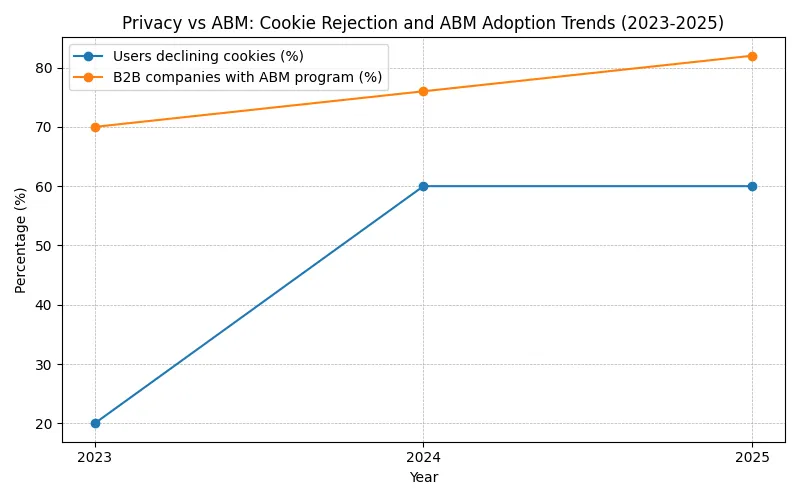Running ABM in channels where Prospects don’t leave breadcrumbs
How to Drive Account‑Based Marketing Results Without Tracking Cookies?
As marketers, we used to follow digital breadcrumbs, a cookie here, an impression there, to nurture prospects down the funnel. Privacy laws like GDPR and CCPA have raised the bar, browsers have started blocking third‑party cookies, and users have begun clicking “reject” on cookie banners.
Roughly one in five consumers now routinely declines cookies. On some websites, up to 60 % of visitors refuse cookie tracking altogether. That means traditional ABM tactics, built around gated content and pixel‑based tracking, no longer deliver the rich behavioural data we once relied on.
We wrote this playbook because marketing leaders still need to hit pipeline targets in a privacy‑first world. We will show how to build account‑based marketing (ABM) programmes when prospects don’t leave digital breadcrumbs. You will learn a signal‑based framework, get actionable tactics beyond cookie‑based advertising, see a real case study, and walk away with a 90‑day plan you can start today.
The privacy‑first crisis and the end of cookie‑driven ABM
Third‑party cookies powered a generation of adtech. They allowed us to see who visited our site, retarget them across the web, and measure conversions. Those days are ending. The marketing team at Huble notes that as privacy awareness grows, up to 60 % of users reject cookies on certain websites. Even first‑party cookies are under scrutiny. With Apple’s App Tracking Transparency and similar moves from Google and Firefox, it is harder to identify anonymous visitors, and the data we do capture is less complete. GWI reports that only one in five people accepts cookies regularly, and Western consumers are even more likely to opt out.
The consequences are profound:
- Incomplete data: downloads, email footprints and pixel‑based impressions used to indicate buying intent. Those signals are fading.
- Broad targeting fails: social media traffic produces volume but little quality. Anonymous searches mean C‑suite executives can research without ever showing up in your analytics.
- Regulatory risks: failing to respect consent will not only damage your brand but can also lead to fines and lost trust.
Yet the need for ABM has never been greater. Surveys show that 70% of marketers already run ABM programmes, and adoption is accelerating – 76% of B2B companies are expected to implement ABM by 2025.
Companies that align ABM with account‑based advertising see 60% higher win rates and ad‑influenced accounts progress 234% faster through the sales pipeline.
The challenge is clear: how do we reap those benefits when the data we used to depend on is disappearing?
Signal framework for low‑visibility channels
Running ABM without granular tracking requires a different mindset. Instead of waiting for prospects to leave breadcrumbs, we must proactively assemble signals from a mix of first‑party data, intent platforms and qualitative research.
Our ABM framework has three layers:
- Foundation signals: Define your ideal customer profile (ICP) using the data you already own. CRM records, closed‑won analyses, customer interviews and firmographic filters (industry, size, revenue, geography) are your starting points. Platforms like Bombora and 6sense can enrich this view with privacy‑compliant intent data, showing which companies are researching topics relevant to your solution.
- Cluster and network mapping: Once you know who you want to reach, group accounts into clusters based on shared attributes. Map the decision‑making unit – not just executives but champions, influencers and gatekeepers. Remember that the average B2B purchase involves about seven stakeholders, so you must identify and engage the whole buying committee.
- Expansion signals: Combine insights from your ICP and clusters with real‑time campaign data to prioritise where to focus. Use server‑side events from platforms like LinkedIn or Google Tag Manager to feed engagement signals straight into your CRM. Score accounts based on intent signals, content consumption and sales feedback. Iterate your messaging and creative based on what resonates.
Why the foundation matters
Cookie deprecation makes first‑party data your competitive advantage. Build content that encourages visitors to share their details voluntarily: ungated case studies, podcasts, ROI calculators and webinars. This self‑reported data is more accurate than pixels. Focusing on champions rather than just decision‑makers also increases your odds of success.
When Drift introduced conversational AI chatbots to capture in‑moment interest, it increased qualified leads by 250%. Engagement begins when you offer value, not when you collect a form fill.
Building high‑intent engagement without cookies
Once your signal framework is in place, shift your tactics from surveillance to service. Here are strategies that work in channels where prospects remain anonymous:
- Champion and influencer targeting. Decision‑makers rarely act alone. Identify internal champions who will advocate for your solution and industry influencers who shape opinion. Tools like G2 and LinkedIn Sales Navigator help uncover those names.
- Content that educates and converts. Publish industry‑specific landing pages, case studies and podcasts that speak directly to common pain points. Create short videos (60–90 seconds) and interactive calculators to demonstrate ROI.
- Highlight improvement results like those achieved by Engagio, 300% higher engagement and 35% faster sales cycles when they planned multi‑channel ABM campaigns.
- Highlight improvement results like those achieved by Engagio, 300% higher engagement and 35% faster sales cycles when they planned multi‑channel ABM campaigns.
- Conversational marketing. Implement chatbots on your website to answer questions, qualify visitors and book meetings in real time. AI agents such as IBM Watson or Intercom gather first‑party data while delivering value.
- Server‑side tracking and CRM integration. Move away from browser pixels; implement server‑side APIs (LinkedIn Conversions API, Google Enhanced Conversions) that respect consent yet provide account‑level insights. Sync these signals with your CRM to map impressions to marketing qualified leads (MQLs) and sales qualified leads (SQLs).
- Partner‑powered ABM. Co‑author white papers or podcasts with complementary vendors, run joint webinars and co‑host offline events. Sharing audiences builds trust and broadens reach without relying on tracking cookies.
- Offline and multi‑touch campaigns. Conferences, roundtables and account‑specific events produce higher conversion rates because you engage prospects face to face. Complement these with follow‑up search and paid campaigns to nurture interested accounts.
Remember that organic search still matters. Create SEO‑optimised content for each vertical you serve. When prospects cannot be tracked, they will search for answers; be there when they do.
Ad‑influenced accounts are 89% more likely to become opportunities, and 75% of B2B marketers say ABM helps them engage the right buyers earlier. However, those campaigns perform best when supported by a library of helpful content.
A 90‑day plan for privacy‑first ABM
Launching a privacy‑compliant ABM programme takes discipline. Here is a roadmap you can follow:
Days 0 - 30: Build your foundation
- Audit your CRM and marketing automation systems to ensure all first‑party data is captured and consented.
- Define your ICP using firmographic, technographic and behavioural data. Use intent platforms like Bombora or 6sense to identify in‑market accounts.
- Create cornerstone content: case studies, podcasts, industry reports and calculators. Optimise your website for SEO and install consent management tools via Google Tag Manager.
- Align with sales on what constitutes a marketing-qualified account and set up shared dashboards.
Days 31 - 60: Activate your campaigns
- Launch conversational marketing tools (chatbots, live chat) to capture real‑time intent.
- Run small‑scale ABM pilots on high‑value clusters using personalised ads, email sequences and direct mail. Focus on engaging champions and influencers.
- Integrate server‑side conversion APIs from platforms like LinkedIn and push engagement data into your CRM for accurate attribution.
- Host partner webinars or podcasts to leverage adjacent audiences and generate mid‑funnel engagement.
Days 61 - 90: Scale and optimise
- Analyse early results with predictive account scoring. Identify which channels and messages drive the highest engagement and pipeline contribution.
- Double down on tactics that work; sunset activities that do not. Use sales feedback to refine your ICP and content.
- Build a community around your niche through LinkedIn groups or Slack communities. Encourage existing customers to share their experiences.
- Prepare to scale by documenting processes, developing playbooks and training your sales team on ABM follow‑up.
Key takeaways and pitfalls to avoid
- Prioritise first‑party data and consent. In a world where up to 60% of visitors refuse cookies, your own data is the most reliable asset. Implement consent management and respect user preferences.
- Align sales and marketing. ABM success depends on collaboration. Companies that synchronise the two teams close deals 67% faster and grow revenue 24% quicker over three years.
- Focus on quality over quantity. Narrow your target list to high‑value accounts and engage them with personalised experiences. Resist the temptation to buy large prospect lists or spam cold leads.
- Invest in content and conversation. Thought leadership, case studies and podcasts build trust. Conversational marketing tools convert interest into opportunity.
- Beware of compliance gaps. Ignoring GDPR/CCPA or deploying browser‑based pixels without consent can harm your brand. Use server‑side integrations and maintain a clear audit trail.
- Embrace a multi‑channel approach. Prospects rarely convert on the first touch. Combine content syndication, ads, events, email and search to stay top‑of‑mind. Remember that 30% of marketers report engaging twice as frequently with C‑level targets through ABM.
- Lead with value. Instead of pushing a hard sell, facilitate insightful conversations and address pain points. Value exchange builds trust and, ultimately, a pipeline.
Privacy vs ABM: the data story
The chart below illustrates the tension between rising privacy concerns and the adoption of ABM over the years.
While the percentage of users declining cookies has surged, the share of B2B companies embracing ABM programmes continues to climb. This underscores why building a privacy‑first ABM strategy is no longer optional but a necessity today.

Driving higher win rates with a privacy‑first ABM strategy
The cookie era is over, but account‑based marketing is not. When we shift our focus from chasing invisible breadcrumbs to building meaningful relationships, ABM delivers exceptional results. It requires us to invest in first‑party data, create valuable content, engage champions and influencers, and measure success based on signals we can control. The statistics are clear: ABM drives higher win rates, faster sales cycles, bigger deal sizes and stronger customer relationships.
Now it is your turn. Are you ready to build an ABM programme that thrives in a privacy‑first world?




